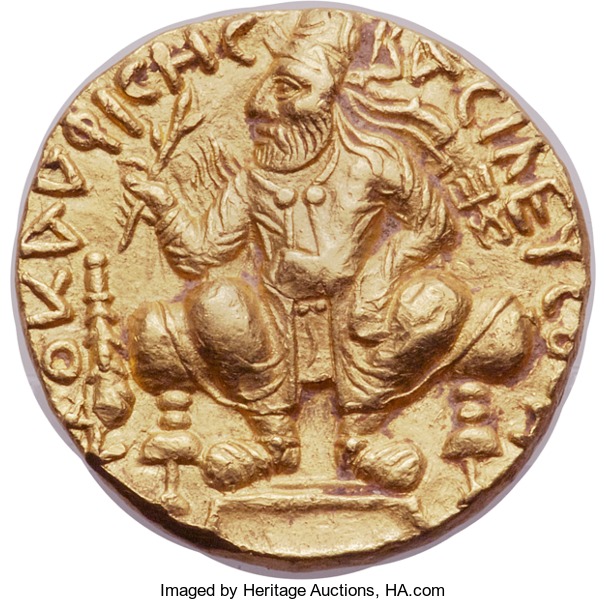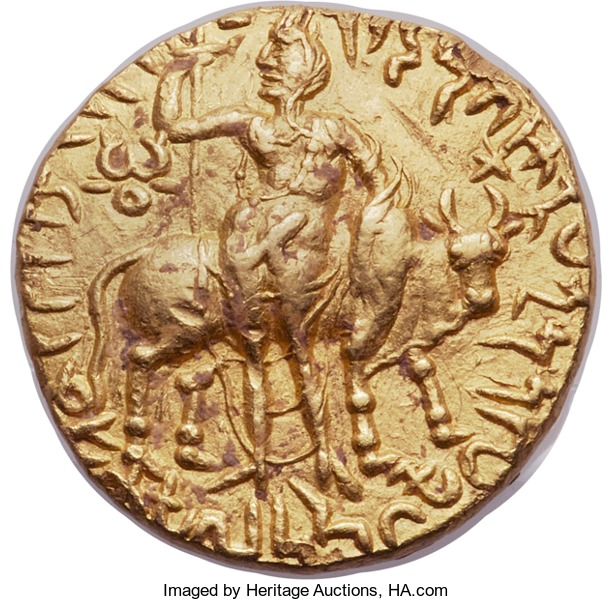By Lorie Ann Hambly for Heritage Auctions ……

Pompeia’s pick this time is a departure from our usual run of Greco-Roman coins: A gold double-dinar of Vima Kadphises, Kushan ruler of northern and central India from 113 to 137 CE
Considering the importance of Ancient India as home of one of the Ancient World’s great civilizations and one of today’s great religions, it is remarkable how little we know about the Kushans, the energetic dynasty that controlled much of India nearly 2,000 years ago. Written records of the era, where they exist at all, are all from other surrounding civilizations and are sketchy, imprecise and lacking in detail. We are even unsure what language the Kushans spoke, whether it was an Indo-European tongue or related to Chinese.
As to the origins of the Kushans, all we really know is that they emerged from western China and swept into the Indian subcontinent like a storm in the second century BCE. They are believed to be a branch of the Yuezhi, fierce nomadic horsemen who can be viewed as a prototype for the later Huns and Mongols (indeed they shared many practices with the Huns). We do not know for certain what the term “Kushan” means, although it could derive from the Chinese Guishang, an aristocratic tribe of the Yuezhi. They first swept through Bactria, occupying modern Afghanistan and western Pakistan, where they assimilated native forms of dress, the Greek alphabet (slightly modified), and a mixture of Iranian and Greek religion.
By the time they reached India, the Kushan culture was a rich blend of Chinese, Iranian, Afghan, Greek and Indian customs, beliefs and modes of dress.
Vima Kadphises
Much of what we do know about the Kushans comes from studying their coinage, which is rich and filled with fascinating syncretic symbolism. Our gold distater of Vima Kadphises, the third Kushan ruler in India, is a case in point. As for the man, like the culture itself he is something of a mystery, although from the symbolism of our coin he seemed to think a great deal of himself (not a rare trait among rulers, ancient and modern).
We do know he was the first Kushan king to strike gold coins – and these are some of the largest and most impressive pieces of any contemporary culture.
His gold distater, or double-dinar, weighs in at 15.95 grams, twice the weight of the only other widely circulating gold coin of the time, Roman gold aureus. The large flan size gave the die engraver scope to portray not just the head or bust of Vima Kadphises but his entire robed royal figure, seated on an elaborate cushioned throne (a variant of this design shows him floating god-like on a bed of clouds). He wears a Greek-style diadem and an unusual elongated skull cap that could actually reflect the shape of his head: Like the Huns, the Kushans seem to have artificially elongated the skulls of their male rulers from infancy.

The reverse portrays the Hindu god Shiva, proudly ithyphallic, the “creator, destroyer and transformer of all things” (the ithyphallic feature no doubt reflecting the “creator” function). Shiva stands with the sacred bull Nandi, guardian of the gates of Kailasa, Shiva’s heavenly abode.
While these deities are part of the Hindu pantheon, the coin also depicts the Buddhist triaratna (“three jewels”) symbol, indicating Vima Kadphises may have favored the Buddhist faith. Indeed his son, Kanishka the Great, was a vocal proponent of Buddhism. In any case, the reigns of Vima Kadphises and Kanishka represented the apogee of Kushan fortunes, and their beautiful coins are one of the few ways they left an enduring stamp on history.
Ancient Kushan Coins Currently Available on eBay
[wpebayads]




